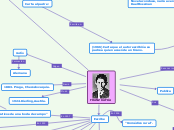Rima
Metafora
Hiperbole
expresiones artísticas y estética
LITERATURA EN LA INFANCIA
To name your story, you have to think about the overall message and what you want your audience to understand from the story. Also, make it relevant and easy to remember.
son
FUNCI´ÓN DE LA LITERATURA INFANTIL.
The ending of a story is essential. We all know that if the ending is weak, what happened before loses its importance. So make it unpredictable, but fair. A resolved ending answers all the questions and ties up any loose threads from the plot.
AXIOLOGÍA
SOCIOCULTURAL
TERAPÉUTICA
LITERARIA
LÚDICA
This is the closure section of the story.
See examples of possible outcomes below:
- all problems have been solved
- it's clear how each one of your characters ends up
- your main character is transformed by the challenge
DIDÁCTICA
This is the moment when the main character surpasses the last obstacle and finally faces their greatest challenge.
The climax usually follows one of these patterns:
- realization
- resolution
- choice
Type in your answer.
FIGURAS LITERARIAS
The middle of the story is where you add layers of complications that will lead to the end. Reveal more about the character's journey. Did their personality go through changes? How did they overcome the challenges? And as you build up the story’s central conflict, make it more personal to that character. Also, from the middle act, you have to lead into the final act.
IRONICA
Entender algo
Escribiendo exactamente
Lo opuesto a la expresión
ONOMATOPEYA
Sonido
emiten
objetos o animales
ANÁFORA
There wouldn't be any tension and excitement in your story if there weren't any obstacles in your character's way.
Extender
Sonidos o repetición
Rítmica de palabras
HIPÉRBOLE
Exageración
Atributos o situaciones
PERSONIFICACIÓN
Your character(s) need(s) motivation in order to solve the challenge(s).
Secondary characters also might have motivs beacuse of which they may cross path with main character or which might trigger them to help the main character.
Animales
Inanimados
Realiza acciones humanas
METÁFORA
Each story has a main character and that character usually needs to solve a problem or challenge. The character's challenge is the one that creates tension throughout the story.
Relacionar
In most stories, there are 3 challenges. The number 3 is a mystical number symbolizing completeness. Try to come up with interesting challenges with which your character needs to struggle.
See a few examples below:
- turns into a werewolf at night
- is sent back in time
Situación
Imágenes
Que se asemejan
GÉNERO LITERARIO
In the beginning of the story (or the exposition), you will need to introduce the setting and characters. You might also want to introduce the main conflict. This part of the story is important because it gives the reader necessary background information and maybe even a first insight into a character’s personality.
GÉNERO DRAMATICO
Tipo tragico
De la vida humana
comedia en escena
GÉNERO LIRICO(POETICO)
The setting (time & place) of a story can change throughout the plot.
Expresa un lenguaje
Your story can take place wherever your imagination will take you to.
For example: in an elevator, in an enchanted forest, etc. Don't forget to give details of the environment each time the setting changes, otherwise, the story can be confusing. Also, mention the seasons as each of them has unique weather and events.
Sensaciones
Emosiones
Sentimental
Abstrato
Estético
GÉNERO NARRATIVO
Characters are essential to a good story. Usually, the protagonist(s) is/are the most affected by the plot. Introduce a character by focusing on their actions, interests, and occupation, as the physical appearance doesn't make a difference in most cases.
Narra o presenta una historia
Type in the name of your character.
Espacio
What is your character's main goal?
fight Evilfind lovedefeat his/her enemyrule the worldmake friendstime travelmake an awesome discoveryOther
Tiempo
Which traits best describe the character's personality? Choose more if necessary:
introvertedloyalkindindependentquick-thinkingadventuresomeidealisticsweet-naturedcalmrisk-takercreativewittystrictfussyweirdclumsyharshaggressivecarelessclingingcowardlycrueldeceitfulimpulsiveOther
FIGURA LITERARIA
Add other properties of the character.
Personificación
Descripción
Personajes
Choose the type of your chacter:
Protagonist (main character)Antagonist (main character's opponent)Flat (stereotypical character)Round (his/ her personality develops throughout the story)Static (doesn't evolve as a person throughout the story)Dynamic (dramatical change in personality)Confidant (the main character trusts him/ her)Foil (contrasting character who enhances the personality of another character)Other










